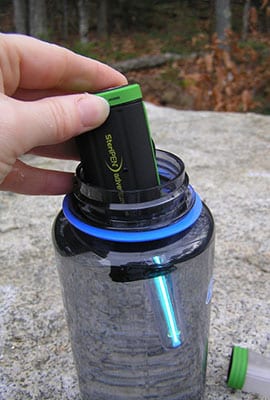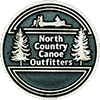Camping Safety
Do we need to be experts in camping and canoeing? NO! But this should not be the first time you have been in a canoe or slept in a tent pitched other than in the back yard.

Elementary map reading skills are handy, but can be picked-up quickly.
While you don’t have to be an accomplished canoeist, a few hours of practice on a local lake or park pond is highly recommended. Your first day on the canoe trails shouldn’t be your first time in a canoe.
We think it is very important that participants:
- Know how to swim.
- Know basic first aid skills
- Are in average physical fitness for their age
- Have average outdoor skills in evaluating weather and water level conditions, and understand how these conditions will effect camping and canoeing
- Have an understanding of their party member’s strengths and weaknesses, physically, as well as in their canoeing and camping skills, and their mental fitness for the trip
The big thing here is that you give us an honest evaluation of your camping and canoeing skills … beginner, novice, advanced, or ready for the “Iron Man Eco-Survival and Endurance Challenge.” Don’t inflate or diminish your skill level. You are not hiring us to be impressed or to be judgmental about your background.
If there is anything else you are unsure about, just ask … it is our business to assist you in preparing for your trip.
Are Canoe Trips Dangerous?
All outdoor activities have some sort of risk. Add to that the risks involved with sports, and the risks involved with isolation and no immediate response medical help, and you will be in the range of a wilderness canoe trip.
However, the inherent risks of a canoe trip pale in the light of not using common sense or taking unnecessary chances.
- Always wear your life jacket while on the water.
- Never run any sort of rapids. Always use the portages … they are there for a reason!
- Never dive into wilderness lakes.
- Never swim above a rapids or falls.
- Use extreme caution swimming below a rapids or falls; currents and undertows are always present to some degree.
- Get off the water if winds increase to the point of making you feel uneasy, or if lightening is imminent due to the proximity of storms.
- Use a great deal of care around fire, whether that be with wood or a gasoline stove. Never take a heat source into your tent.
In short, always consider the risk involved with whatever you are planning to do. If there is little benefit, or there is more than slight risk of injury or death, DON’T DO IT ON A CANOE TRIP! Read our Risks page.
White water and rapids
The wilderness making up the BWCA and Quetico Park is considered a lakeland situation, not a series of rivers. Where travel takes a paddler on one of our major rivers (the Kawishiwi and Isabella in the BWCA, and Quetico’s Maligne River and “Fall’s Chain”), the impression is more of a long narrow lake versus a flowing river. The lesser rivers, such as the Horse, Nina-Moose, Indian Sioux, normally have a slow flow and not much volume. Between some connecting lakes, and interspersed along our rivers, are a few rapids or small falls. Only a handful of these would be of any interest to a “kayaker” or “river runner”.
Running rapids here in the north country is bad practice and here’s why:
There is a high probability for ending up in the water if not done correctly. Rarely does this, in itself, present a hazard to the paddler. (While there have been a few drownings, in these cases each of these individuals were not wearing their life jackets.) But from a materialistic point of view, packs get soaked, sleeping bags are soggy, tents are wet, and food is ruined. Hundreds of fishing rods and tackle boxes have ended up on the bottom. These occurrences can really be a negative impact on the success of a canoe trip, and can be very expensive.
A drive down Ely’s main street will take you past several outfitting companies. In front of some of them, you can see bent and folded canoes. Each is accompanied by a sign telling of some customer that tried to run a set of rapids and ended up destroying the canoe. Here at North Country, we, too, have several canoes that have cost customers hundreds of dollars in additional costs to pay for their lack of good judgment. Each of these people were specifically warned to STAY OUT OF RAPIDS and to ALWAYS USE THE PORTAGES. Yet most had some excuse as to why an additional charge of $500 to $1500 shouldn’t be charged to their Visa credit card. “It didn’t look that hard” or “The other two canoes got through OK” or “Isn’t that covered by equipment insurance?” (NO!)
Unlike paddling the rivers in Nebraska, Ohio, Missouri, or Arkansas, if there is a problem, there is “no farm house just over the hill to call from”. Here in the canoe country, a wrecked canoe means the trip stops right there. The only way out is to wait for some other paddler to come by (a few hours or maybe the next day), and talk them into changing their plans to give one of you a ride out. (Canoes don’t hold four people.)
In short, if you want to insist on shooting rapids along your trip, or even if you think you might be tempted to “give it a try” on one of the small ones … do us a big favor:
USE ANOTHER OUTFITTER!
Drinking Water Safety

Although the northern lakes may look pure, there could be a rare problem with giardia lamblia (often called Giardia), a water cyst which can cause unpleasant intestinal illness. It is interesting to note that we’ve never had a guest get sick from the water since we started almost a quarter of a century ago. With that said, however, it is best to treat drinking water by one of the following methods:
-
Use a SteriPen (North Country’s recommended method)
(See image) These are a flashlight type item which uses Ultraviolet light to sterlize water. They are included as part of our Ultra-light GOLD Packages, or can be rented as an additional item. For our Complete Parties using our SILVER, SILVER +, or Non-Profit Youth Group Packages, we discount the rental by about 30%.
-
Boil your water
Bring water to a full boil for at least one minute, then let stand until cool enough to drink. We suggest you do this with the large cooking pot after dinner, and let it cool overnight. Then just fill your drink bottles in the morning; you’re good for the day.
-
Use tablets to purify
In our shop we sell tablets (chlorine, iodine, or halizone base) to treat your water. Follow manufacturer’s directions for use. Cold or cloudy water will take longer to treat and may require additional tablets.
-
Purify or filter your water
Use a purifer or filter to that is specifically designed to remove giardia lamblia. The problem here is that the filters will plug with algae very easily. For this reason, we personally do not recommend (or use) filters.
-
The Voyageur method
Many of our guests use the straight out of the lake method. If you use this method you must do it correctly: away from shore and in water that is deeper than you can see bottom. (Especially avoid the stagnant bays and small streams where beaver and moose are commonly seen.) Take your water bottle and gather your drinking water at least an elbows length deep, cap it and return to surface.
Anyone with a medical condition, or a pregnancy, should boil, filter, or treat their drinking water.
Please read more about safety at our Camping and Canoeing Risks page.
